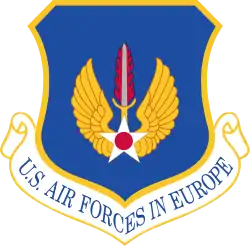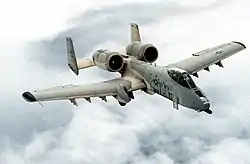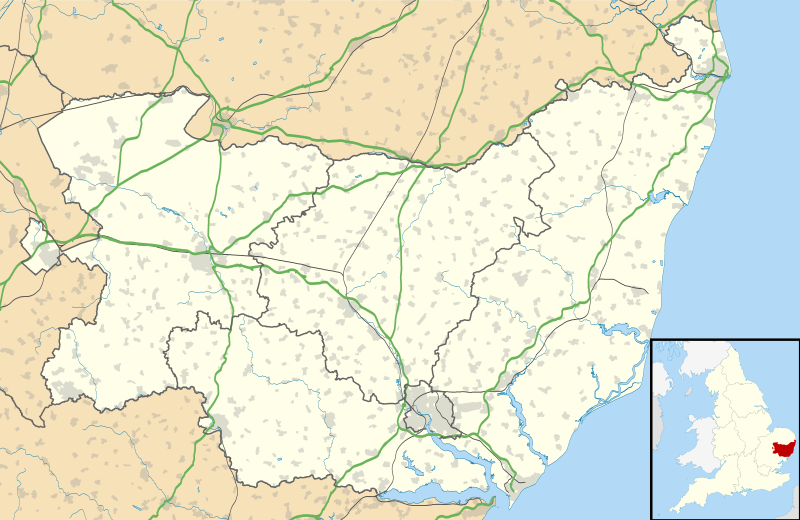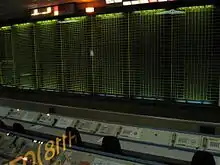RAF Bentwaters
Royal Air Force Bentwaters or more simply RAF Bentwaters, now known as Bentwaters Parks, is a former Royal Air Force station about 80 miles (130 km) northeast of London and 10 miles (16 km) east-northeast of Ipswich, near Woodbridge, Suffolk in England. Its name was taken from two cottages (‘Bentwaters Cottages’) that had stood on the site of the main runway during its construction in 1943.
RAF Bentwaters | |||||||
|---|---|---|---|---|---|---|---|
| Rendlesham, Suffolk in England | |||||||
 A Fairchild Republic A-10A Thunderbolt II assigned to the 81st Tactical Fighter Wing, which was based at RAF Bentwaters between 1951 and 1993. | |||||||
 RAF Bentwaters Location in Suffolk | |||||||
| Coordinates | 52°07′41″N 001°26′07″E | ||||||
| Type | RAF flying station (US Visiting Forces) | ||||||
| Site information | |||||||
| Owner | Ministry of Defence | ||||||
| Operator | Royal Air Force (1942–1949) United States Air Force (1951–1993) | ||||||
| Condition | Closed | ||||||
| Site history | |||||||
| Built | 1941–1944 | ||||||
| In use | 1944–1993 | ||||||
| Fate |
| ||||||
| Airfield information | |||||||
| Identifiers | IATA: BWY, ICAO: EGVJ, WMO: 035963 | ||||||
| Elevation | 26 metres (85 ft) AMSL | ||||||
| |||||||
The station was used by the Royal Air Force (RAF) during the Second World War, and by the United States Air Force (USAF) during the Cold War, being the primary home for the 81st Fighter Wing under various designations from 1951 to 1993. For many years the 81st Fighter Wing also operated RAF Woodbridge, with Bentwaters and Woodbridge airfields being known by the Americans as the "Twin Bases".
RAF Bentwaters is also near the location of the alleged December 1980 UFO incident in Rendlesham Forest.
The site is now known as Bentwaters Parks. The Bentwaters Cold War Museum is located on the site, there are offices and warehouses, and the site is also used for television and film making.[1]
History
Second World War
Bentwaters airfield's origin dates to 1942 when construction began on a Royal Air Force station called Royal Air Force Butley for use by RAF Bomber Command. On 28 January 1943 the station was renamed Royal Air Force Bentwaters. It was opened for operational use in April 1944. In December it was transferred to No. 11 Group, RAF Fighter Command . During the Second World War, RAF squadrons at Bentwaters were:
- No. 64 Squadron RAF between 29 December 1944 and 15 August 1945 with North American Mustang III moved to RAF Horsham St Faith.[2]
- No. 65 Squadron RAF between 15 May 1945 and 13 August 1945 with Mustang IV moved to RAF Fairwood Common.[2]
- No. 118 Squadron RAF between 15 December 1944 and 11 August 1945 with re-equipped Mustang III moved to RAF Fairwood Common.[3]
- No. 126 Squadron RAF between 30 December 1944 and 5 September 1945 with Mustang III then upgrading to Mustang IV in August 1945.[4]
- No. 129 Squadron RAF between 11 December 1944 and 26 May 1945 with Mustang III, swapping to Supermarine Spitfire IXE in May 1945.[5]
- No. 165 Squadron RAF between 15 December 1944 and 29 May 1945 with Mustang III until May 1945 then the Spitfire IXE.[6]
- No. 234 Squadron RAF.[7]
- No. 245 Squadron RAF.[8]
Two other units were also based at Bentwaters, these were No. 226 Operational Conversion Unit RAF and No. 7 Fighter Command Servicing Unit.[9]
In addition to its RAF use, United States Army Air Forces (USAAF) fighters flew escort missions for RAF Bomber Command from Bentwaters beginning on 4 May 1945.
The USAAF designation for Bentwaters was AAF Station 151.[9]
The squadrons were:
- No. 56 Squadron RAF reformed here on 1 April 1946 and stayed until 16 September 1946 with the Gloster Meteor F.3 moving to RAF Boxted.[10]
- No. 74 Squadron RAF between 2 June 1946 and 9 June 1945 with Meteor F.3s moved to RAF Colerne.[11]
- No. 124 Squadron RAF between 5 October 1945 and 18 February 1946 with Meteor F.3s moving to RAF Fairwood Common. The squadron returned on 20 March 1946 and stayed until 1 April 1946 still with the Meteor F.3 before being renamed 56 Squadron.[4]
- No. 2707 Squadron RAF Regiment.[9]
- No. 2791 Squadron RAF Regiment.[9]
- No. 2839 Squadron RAF Regiment.[9]
USAF use
Control of Bentwaters was transferred to the United States Air Force on 16 March 1951 by the Ministry of Defence, and the United States Air Forces in Europe (USAFE) designated it a primary installation of HQ USAFE on 7 September 1951. Bentwaters was to play a key role in the defence of Western Europe during the Cold War when large numbers of USAF aircraft were assigned as part of the air arm of NATO.
On 16 March 1951, the USAF 7506th Air Support Group was assigned to Bentwaters. Their mission was to bring the facility up to NATO standards. During most of 1951 and 1952 USAF construction upgraded the operational facilities, as well as the construction of support facilities. Early USAF units at Bentwaters were as follows:
- 9th Air Rescue Squadron (July 1951 – November 1952) (Boeing SB-29 'Super Dumbo'). This unit flew air-sea rescue missions with aging B-29 aircraft adapted to drop airborne lifeboats. It received its nickname from earlier "Dumbo" missions that picked airmen up when they crashed at sea. The unit departed in November 1952 for RAF Burtonwood.
- 7554th Target Tow Flight (March–December 1952) (Stinson L-5E, Douglas TB-26C). This unit flew aerial targets for gunnery practice by NATO aircraft.
81st Tactical Fighter Wing

The 81st Fighter-Interceptor Wing became the new host unit at Bentwaters in September 1951. The 81st, in various designations, remained at RAF Bentwaters for over 40 years during the Cold War era. The 81st FIW was a North American F-86A Sabre equipped unit, being activated at Moses Lake AFB, Washington in May 1950. In August 1951 the 81st flew initially into RAF Shepherds Grove, then in September transferred its headquarters to RAF Bentwaters.
In October 1974, the 81st began operating F-4D Phantoms. This would continue through early 1979, when the wing received and began operating the A-10A Thunderbolt II, affectionately known as the warthog. The D model Phantoms were transferred to the 401st TFW at Torrejón AB, Spain.
An A-10 forward operating location was established at Sembach Air Base West Germany on 1 September 1978 when Det. 1, 81st Tactical Fighter Wing was activated. Revetments and a dozen hardened aircraft shelters were built and A-10A Single-seat attack fighters began operations at Sembach during May 1979. Additional detachments were subsequently established at Leipheim, Alhorn and Norvenich Air Bases in West Germany and at two additional unmanned reserve Forward Operating locations which remain classified; one in the north of Germany and one in the south, both in rear of the other four named bases/airfields. A-10's and support resources routinely rotated to these Forward Operating Locations from RAF Bentwaters for training and Tactical Evaluations. The C-130 rotating to the detachments was affectionately called "The Klong". In the event of war in the 1980s, the Bentwater A-10's were to fight from Germany, and Bentwaters would host F-16's from Nellis AFB and from Myrtle Beach AFB, South Carolina.
Post Cold War
With the end of the Cold War, the USAF presence at Bentwaters was gradually phased down. It was announced that the station would be closed and the 81st TFW would be inactivated. The Bentwaters-based squadrons were phased-down as follows:
- 510th Tactical Fighter Squadron was transferred to the 52nd Fighter Wing at Spangdahlem Air Base Germany on 4 January 1993. On 1 February 1994 it was inactivated at Spangdahlem, but it was reactivated on 23 March 1994 as a Block 40 F-16C/D squadron at Aviano Air Base Italy.
- 92nd Tactical Fighter Squadron was inactivated on 31 March 1993. Its aircraft were sent back to the United States to various Air National Guard squadrons.
The last A-10 aircraft departed Bentwaters on 23 March 1993, and the 81st Tactical Fighter Wing was inactivated on 1 July 1993. With the inactivation, the USAF returned control of Bentwaters to the Ministry of Defence.
Currently, Bentwaters airfield is inactive as a military facility.
Current uses
With the handover of Bentwaters back to the UK Ministry of Defence in 1993, the facility was closed. It is now known as "Bentwaters Parks".
Bentwaters Cold War Museum
.JPG.webp)

In 2003, work commenced on the Bentwaters Cold War Museum (BCWM).[12]
Television and media
In 2008 an episode of the History Channel's UFO Hunters entitled "Military vs. UFOs", was aired. The episode focused on RAF Bentwaters' 1956 and 1980 UFO incidents.[13]
References
Citations
- "Bentwaters Parks". Bentwaters Parks. Retrieved 4 August 2009.
- Jefford 1988, p. 45.
- Jefford 1988, p. 57.
- Jefford 1988, p. 58.
- Jefford 1988, p. 59.
- Jefford 1988, p. 64.
- Jefford 1988, p. 75.
- Jefford 1988, p. 77.
- "Bentwaters (Butley)". Airfields of Britain Conservation Trust. Retrieved 3 November 2012.
- Jefford 1988, p. 43.
- Jefford 1988, p. 48.
- "Bentwaters Cold War Museum". Bentwaters Cold War Museum. Retrieved 1 February 2016.
- "Archived copy". Archived from the original on 27 January 2011. Retrieved 11 September 2013.CS1 maint: archived copy as title (link) US Nuclear Weapons Have Been Compromised by Unidentified Aerial Objects
Bibliography
- Jefford, C.G. RAF Squadrons, a Comprehensive Record of the Movement and Equipment of all RAF Squadrons and their Antecedents since 1912. Shrewsbury, Shropshire, UK: Airlife Publishing, 1988. ISBN 1-84037-141-2.
- Ravenstein, Charles A., Air Force Combat Wings Lineage and Honors Histories 1947-1977, Office of Air Force History, 1984
- Endicott, Judy G., USAF Active Flying, Space, and Missile Squadrons as of 1 October 1995. Office of Air Force History
- Menard, David W., Before Centuries. USAFE Fighters 1948-1959
- Martin, Patrick, Tail Code: The Complete History Of USAF Tactical Aircraft Tail Code Markings, 1994
- Rogers, Brian, United States Air Force Unit Designations Since 1978, 2005
- USAAS-USAAC-USAAF-USAF Aircraft Serial Numbers--1908 to present
- Bentwaters Aviation Society History of RAF Bentwaters
External links
| Wikimedia Commons has media related to RAF Bentwaters. |
- Map sources for RAF Bentwaters
- Bentwaters Air Base Cold War Pictures
- 527th TFAS At Bentwaters Website
- Bentwaters Aviation Society
- Bentwaters Cold War Museum
- Bentwaters Park
- Bentwaters-Woodbridge page - "Thousands of pictures, names, memories, links, past and present from RAF Bentwaters and RAF Woodbridge"
- Space Cadets at Bentwaters - precise filming locations using online maps and aerial photos
- Photographs of Bentwaters in use as a trackday venue
- the UnOfficial 81st SPS RAF Bentwaters/Woodbridge Site - the UnOfficial gathering place for the men & women who served in the USAF 81st Security (Air) Police Squadron at RAF Bentwaters and RAF Woodbridge.
